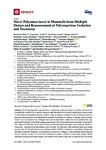Novel Polyomaviruses in Mammals from Multiple Orders and Reassessment of Polyomavirus Evolution and Taxonomy
Ehlers, Bernhard
Anoh, Augustin E.
Ben Salem, Nicole
Broll, Sebastian
Couacy-Hymann, Emmanuel
Fischer, Daniela
Gedvilaite, Alma
Ingenhütt, Nanina
Liebmann, Sonja
Martin, Maite
Mousson, Arsene
Mugisha, Lawrence
Muyembe-Tamfum, Jean-Jacques
Pauly, Maude
Peréz de Val, Bernat
Preugschas, Hannah
Richter, Dania
Schubert, Grit
Szentiks, Claudia A.
Teichmann, Tamara
Walter, Cornelia
Ulrich, Rainer G.
Wiersma, Lidewij
Leendertz, Fabian H.
Calvignac-Spencer, Sébastien
As the phylogenetic organization of mammalian polyomaviruses is complex and currently incompletely resolved, we aimed at a deeper insight into their evolution by identifying polyomaviruses in host orders and families that have either rarely or not been studied. Sixteen unknown and two known polyomaviruses were identified in animals that belong to 5 orders, 16 genera, and 16 species. From 11 novel polyomaviruses, full genomes could be determined. Splice sites were predicted for large and small T antigen (LTAg, STAg) coding sequences (CDS) and examined experimentally in transfected cell culture. In addition, splice sites of seven published polyomaviruses were analyzed. Based on these data, LTAg and STAg annotations were corrected for 10/86 and 74/86 published polyomaviruses, respectively. For 25 polyomaviruses, a spliced middle T CDS was observed or predicted. Splice sites that likely indicate expression of additional, alternative T antigens, were experimentally detected for six polyomaviruses. In contrast to all other mammalian polyomaviruses, three closely related cetartiodactyl polyomaviruses display two introns within their LTAg CDS. In addition, the VP2 of Glis glis (edible dormouse) polyomavirus 1 was observed to be encoded by a spliced transcript, a unique experimental finding within the Polyomaviridae family. Co-phylogenetic analyses based on LTAg CDS revealed a measurable signal of codivergence when considering all mammalian polyomaviruses, most likely driven by relatively recent codivergence events. Lineage duplication was the only other process whose influence on polyomavirus evolution was unambiguous. Finally, our analyses suggest that an update of the taxonomy of the family is required, including the creation of novel genera of mammalian and non-mammalian polyomaviruses.
Dateien zu dieser Publikation
Keine Lizenzangabe

